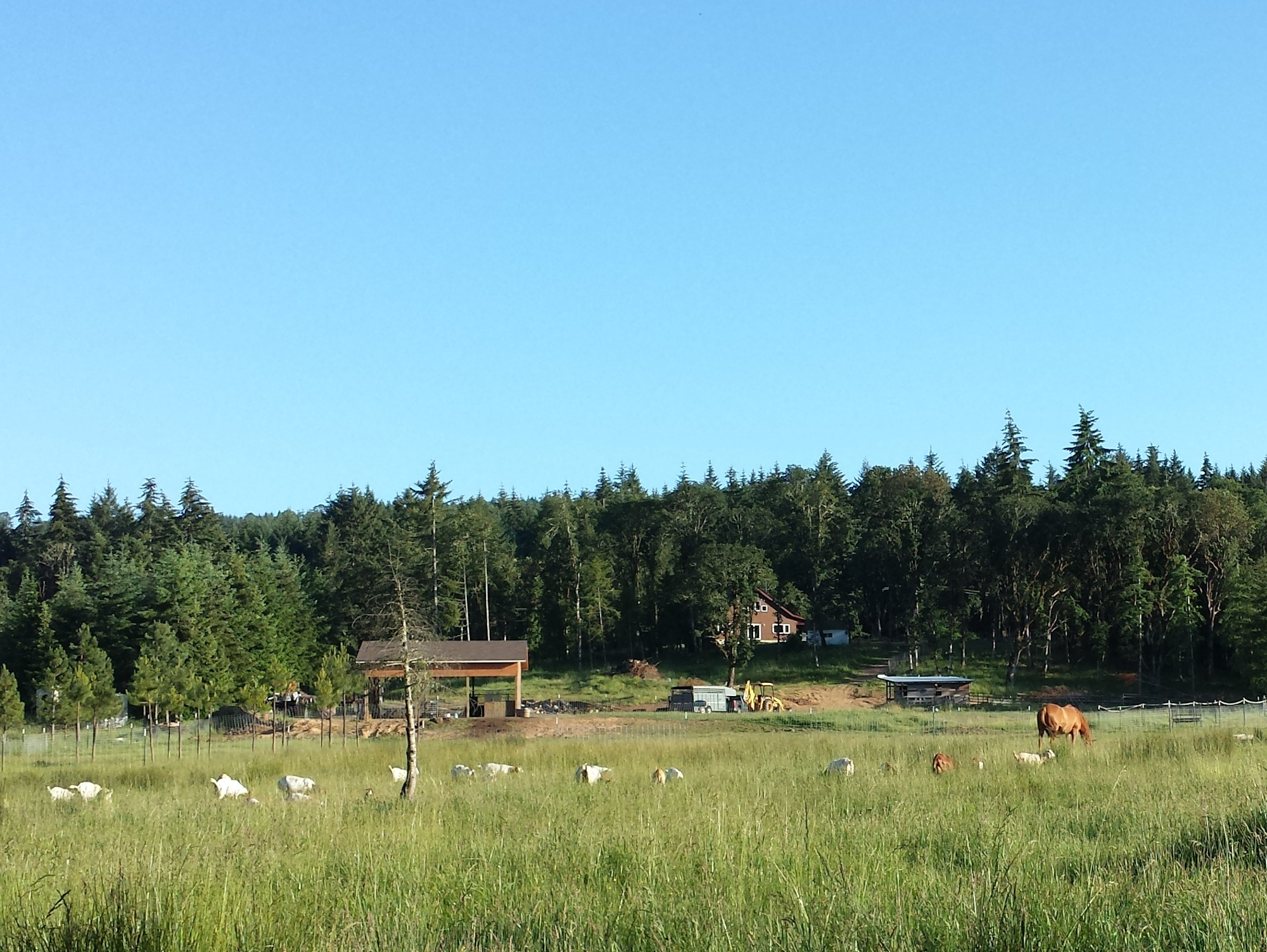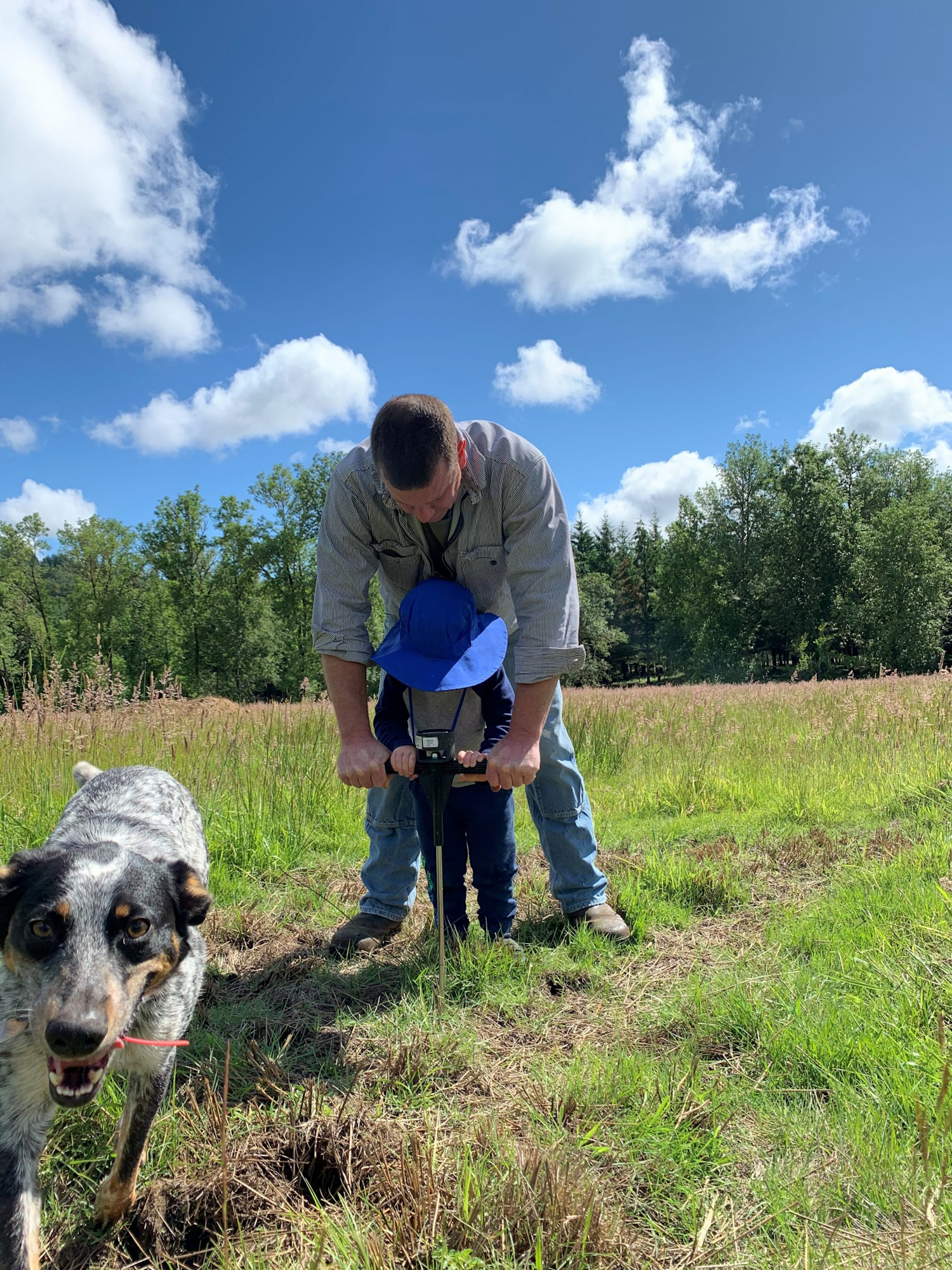The Dirt | Conservation Neighbor: RD Mosier

Growing up in the Coburg, Oregon area, RD Mosier’s father was a large animal veterinarian, and his mother was active in OSU Extension programs. As a kid, he participated in Lane County 4-H, so raising livestock is a natural lifestyle choice. After living in south Benton County for a year, RD Mosier decided it was a good place to settle down. In 2007, he purchased property on Cherry Creek Road. RD reflects that after several years of trial and error, his new ground was “too soft” for beef, a sign that even his early management was driven by observations and what is best for the land. That concept continues to be the foundation of RD’s conservation ethic, “Take care of the land and the land will take care of you.” Working with OSU extension service and listening to several local producers, RD began to develop his vision for future pasture health and livestock production. Production with goats began in 2008 to clean up poison oak and blackberries. Goats are excellent browsers for invasive weed control, with their nibble and move pattern. RD added butcher lambs to his grazing operation in 2010. It was difficult to find a steady lamb source, so he bought a ram with neighbor Dennis Rivera in 2015 and began developing his own herd. Together they strived to develop genetics suited to the area until Dennis moved to Alsea in 2018 to manage Leaping Lamb Farm.
When one’s roots are from a solid family core, community collaboration may be a natural transition.
The challenge of 21st century land ownership is the cost of the land. RD realized that to expand his livestock production, additional pasture for grazing was required. He found that land in the local area was not only expensive at $10K or more per acre, but generally unavailable. Working with neighbors, RD has grown a community grazing operation, inspired by several former 4-H friends and his father-in-law. He learned about developing working relationships to build cooperative pasture and woodland management. Each partner shares in the benefits and the quality of the land resource improves. His neighbors’ lands were minimally managed and suffered from compaction due to historic overgrazing, forage decline, encroaching weeds, and overstocked woody plants, the presence of which increase fire risk. RD envisioned that he could graze livestock on his neighbors’ land, and the additional acreage would allow him to continue expansion of his herds while the land would improve from properly managed grazing as a cost-effective alternative to mowing. Win, win.
RD’s early start on collaborative grazing was with a neighbor, a few houses down, on an irrigated pasture. He helped work the ground and revitalize the pastures for a return to intensive grazing. RD notes that sheep grazing made huge improvements in grass productivity there. They move a herd of sheep onto the pasture for fast grazing. “It looks manicured afterwards.” he says with pride. This pasture is now regularly scheduled in RD’s annual rotational grazing plan.

To RD’s northeast, the James family owns a plot of land. He has worked with them on fencing and woody vegetation removal. His happy sheep and goats help control invasive weeds in the James’ fenced pastures and are used in rotation with another collaborative grazer’s herd of 20 cattle. Someday RD hopes to build a herd large enough to fully engage in intensive grazing but until then he works with other grazers to help keep the volume of vegetation under control. He notes that grazing is very effective in the control of two common aggressive, sun-loving weeds found in pastures and along roadsides: Queen Anne’s lace, (Daucus carota) and tansy ragwort (Jacobaea vulgaris). Tansy ragwort is a regulated Class B toxic biennial. Eating tansy can sicken or even kill cattle, horses, some goats, pets, and people. RD uses grazing to emulate the use of fire for management, without the impacts of smoke and ash. The varied species approach to grazing also helps manage the different types of forage available. The sheep and goats typically start out the rotation eating the poisonous and broadleaf species down in the spring before cattle arrive in early July.

In 2019, after receiving the Upper Muddy Creek Strategic Implementation Area (UMC SIA) announcement from the Oregon Department of Agriculture, RD contacted BSWCD to learn more about our services. I first visited RD’s property with Donna Schmitz, to provide technical assistance for manure management, an ODA water quality concern. We shared pertinent conservation publications and books. It was obvious that RD was motivated and conscientious. The Mosier site visit was a family affair. Our tour of RD’s land was joined by wife, Jessica, toddler sons, Delton and Clayton, two family dogs, a horse, a herd of goats, and a couple of cows. The sheep, that were grazing a neighbor’s pasture, missed all the fun.
After our visit, RD began to implement practices to improve his management, such as gutter installation to move surface water away from his livestock barn. His long-term plan includes construction of an additional winter sacrifice area and drainage improvements. As we walked his land and listened to his stories, we came to appreciate his interest in doing right for the land. We introduced him to the NRCS Tangent Field office staff, Amy Kaiser, Benton County District Conservationist, who helped him submit an EQIP application for potential funding. Kelly Albers, the NRCS engineer, has designed a grassed waterway to direct and slow runoff away from RD’s barn to the downslope pond. Kelly has also provided designs for a pond spillway and brush dams to address erosion and protect Belknap Creek.

RD’s advice to new rural residents is “Get to know your neighbors.”
RD gleans information from friends who have farming experience. They advised him to work with a local crop advisor who made fertilizer and seed recommendations when RD started his pasture renovation. With funds from the Benton SWCD Soil Quality Project, we helped him collect and submit soil samples and paid for the lab analysis. The soil tests will allow him to make informed nutrient management decisions, such as the use of lime for pH adjustment, and to track grazing impacts on the pastures’ soil health. RD used the BSWCD compaction tester to understand surface and subsurface soil conditions.
RD does not rely on his land for his living. Other fulltime gainful employment gives him more freedom to keep from cutting corners in his operation and make long term choices that are right for the environment. RD’s livestock operation is not certified organic, but he feels that it is as organic as possible considering the time frame within which he wants to improve his pastures. He uses organic inputs, such as manure from dairies and wood chips from local tree trimming. He composts all the manure from the stock winter dry lot.
RD compares his livestock operation to the pieces of a puzzle. Some pieces take a long time to fit in place, such as the six years that he has invested to develop relationships with neighbors. He has come to understand that building trust and collaboration are keys to success. Whether the landowner is relatively new to the land or well-seasoned, everyone likes to have a part and see the success. RD believes that the benefits you get out of your operation are relevant to what you put in. He tries to make the best choices for agronomics, beyond simple economics. He recalls a bumper sticker that stuck in his mind and continues to shape his management approach, “Every day is Earth Day for farmers and ranchers.”

When asked where his favorite place in Benton County is, RD quickly replied, “my pastures.” RD feels a sense of success from watching the spring pasture grass emerge and seeing how the pastures improve year after year. The robust pasture growth and visible improvements are tangible measures of his accomplishments. In another five years, maybe this phase of pasture improvement will be complete and what needs to be done next will be more obvious. For now, he enjoys collaborating with his neighbors, working together on a vision of community land management that they can document and refine over time.

